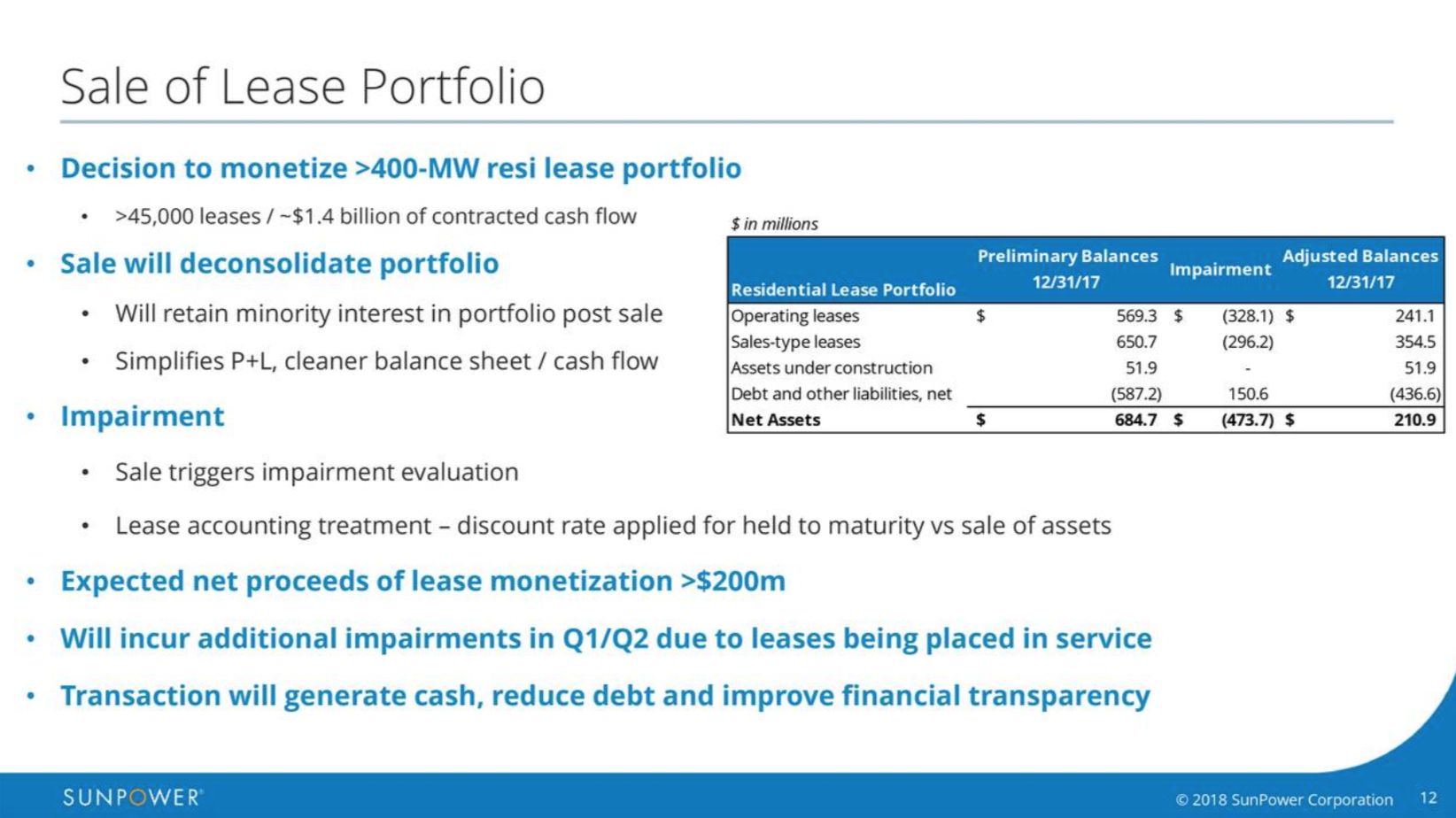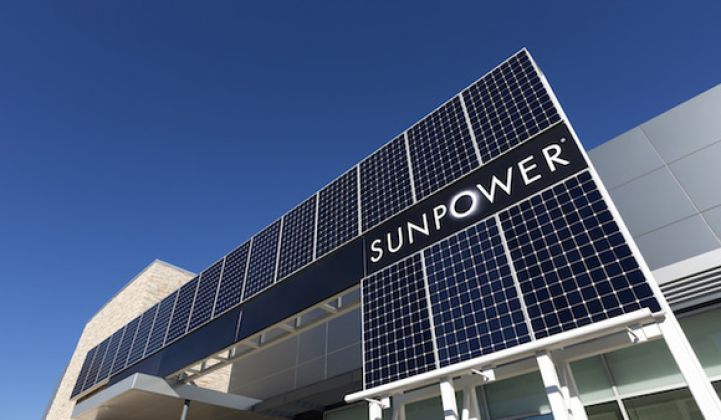Solar company SunPower is bracing itself for the impact of the Trump administration’s recently issued tariffs on imported solar cells and modules.
The company -- based in Richmond, Calif. and majority-owned by French oil giant Total -- could be hit harder than most in the U.S. solar sector due to its international manufacturing base in the Philippines and Mexico, a well as its high-efficiency solar panels with advanced technology that takes on a price premium.
While seeking an exclusion from the import tariff, SunPower said in its fourth-quarter earnings call last week that it is already experiencing negative effects on its business as a result of the increased costs from the Section 201 trade case.
The import tariffs “have delayed certain 2018 projects and made other projects uneconomical,” said SunPower CEO Tom Werner on the call. Werner said the company has already implemented a hiring freeze and has reduced some discretionary programs.
SunPower released additional information on its cost-cutting efforts today in an SEC filing, including plans to reduce non-manufacturing headcount by 150-250 employees by mid-2019, representing approximately 3 percent of the company’s global workforce. SunPower expects to incur restructuring charges totaling $20 million to $30 million, largely related to severance benefits and real estate lease terminations.
Last month, the company announced that it had pre-emptively stopped a planned $20 million investment that would have been used to expand manufacturing of the company’s next-generation solar cells. The move led to the loss of hundreds of new jobs that would have been created in California and Texas, said SunPower.
Werner estimated on last week's earnings call that the impact of the tariff on SunPower’s earnings could be somewhere between $50 million to $100 million. In response to a question from an analyst, Werner explained: “[T]o scale the impact of 201 for 2018, it depends on mix, of course, and the safe harbor material and all those sorts of things, but the impact on EBITDA is between $50 million and $100 million.”
SunPower argues for tariff exemption
After months of speculation, last month the Trump administration issued the new 30 percent year-one tariff on imported solar cells and modules. The tariffs decline over a four-year period and the first 2.5 gigawatts of imported cells are excluded in each of those four years.
While the tariff could give a boost to solar companies that manufacture cells and modules in the U.S., it will raise costs for companies making solar cells abroad, as well as companies relying on low-cost imports of solar cells and modules made outside of the U.S.
GTM Research predicts that the price of solar panels will rise by 10 cents a watt on average in the first year of the tariff. At the same time the U.S. solar industry is expected to see a net reduction in installations of 11 percent this year.
As GTM Research's MJ Shiao put it, the tariff will have a “meaningful but not destructive impact" on solar installations in the U.S.
The U.S. utility-scale solar market could see the largest decline, by close to 5 gigawatts, over the next five years as a result of the tariffs. SunPower has a large utility-scale solar power plant development business, which it is trying to move away from.
SunPower could avoid the negative effects of the tariff on its business if it can manage to convince the Trump administration to give it an exemption. Companies can apply to have certain solar products exempt from the import tariff.
SunPower said in its earnings call that it should be exempt because only it can make “a copper-plated, interdigitated back contact solar cell.” With the exclusion, the company said it would be able to invest in further research and development of that technology.
From “what we've read so far, [it] suggests that we're a good fit for exclusion. We’ll see,” said Werner.
Werner also said that if the company receives an exemption, it would likely be able to recapture the majority of the lost business.
Selling leases to raise cash
Companies need to file for exemptions with the Office of the U.S. Trade Representative. Details of the exemption process were announced on February 14 (the day SunPower held its earnings call), and companies have 30 days to file for the exclusion. There will be another 30 days of a public comment period, and then the administration will make its decisions.
However, in case SunPower does not receive an exclusion, the company is already looking to cut costs. SunPower has also been in the process of streamlining its business and improving liquidity before the tariffs were announced to address fluctuating global solar markets.
In the run-up to the exemption decision, SunPower said it has been building up safe-harbor inventory in the U.S. It’s got at least three months' worth of tariff-free solar panels stocked. At the same time, the company has been looking to grow its international business.
One of the strategies that SunPower has used to create more liquidity has been to sell off assets. That started with the sale of SunPower’s stake in YieldCo 8point3.
The company also plans to sell its leases, which include 45,000 contracts that deliver monthly payments from 400 megawatts of rooftop solar panels. Werner said last week that SunPower hopes to close the lease sale “in the first half of this year,” and that it could generate “$200 million in cash.”
SunPower plans to use the proceeds from the lease sale to help pay for a $300 million convertible bond due in June. However, the leases have been estimated to hold long-term value of $1.4 billion, and SunPower was also forced to take a non-cash charge of $474 million in the fourth quarter.
Overall, Wall Street didn’t take kindly to SunPower’s earnings and cost-cutting news last week. The company’s stock dropped close to 5 percent on earnings day, though it has since rebounded.

For the fourth quarter of 2017, SunPower generated revenue of $658.1 million, down from the $1.02 billion it generated in the fourth quarter of 2016. At the same time, the solar company lost $558.7 million in the recent fourth quarter, which was more than double the loss it had of $275.1 million in the fourth quarter of 2016.
For the full year SunPower generated $1.87 billion in revenue in 2017, down from the $2.56 billion it generated in 2016. Its net loss was $851.2 million this year, which was significantly higher than its net loss of $471.1 million in 2016.
The analysts at Baird Equity Research described SunPower as facing “a transition year.”
“Although 2018 will be a transition year, we are not downgrading shares as we believe SPWR is effectively managing industry and regulatory headwinds while it ramps P Series and NGT production,” wrote Baird analysts.
Bright spots for SunPower continue to be its commercial and residential solar development businesses, and its increased use of energy storage for commercial customers. SunPower reported a 30 percent solar-plus-storage attachment rate with a project pipeline valued at $60 million.




